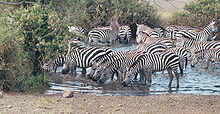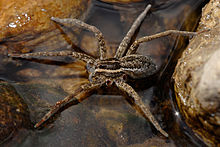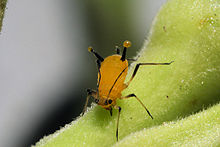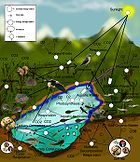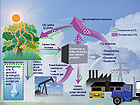- Antipredator adaptation
-
 A lone bison is standing its ground against a pack of wolves, thereby increasing its chance of survival
A lone bison is standing its ground against a pack of wolves, thereby increasing its chance of survival
Antipredator adaptations are evolutionary adaptations developed over time, which assist prey organisms in their constant struggle against their predators.
The act of a predator acquiring a food source can be divided into four stages: detection, attack, capture and consumption.[1][2] At every stage in this predatory sequence, adaptations that maximize the prey's chance of survival have evolved. This, in turn, has driven adaptation in their predators. This kind of interaction over long periods is known as co-evolution.
Many predatory animals are themselves preyed upon. To defend themselves, predatory animals often use their methods of attacking prey to inflict or threaten grievous injury to their own predators. For example, the electric eel uses the same electrical currents to kill prey, and to defend itself against predators (such as anacondas, caimans, jaguars, egrets, cougars) which prey on fish of similar size to the eels.
Contents
Animal adaptations
The butterfly Kallima inachus masquerades as a dead leaf to avoid detection
Avoiding detection
For a predator to locate a potential meal, it must first identify an organism as prey. Prey, however, have many adaptive characteristics which make such a task difficult. Crypsis is the ability of prey to evade detection by predators (or vice versa).
Camouflage is one heavily utilised method, and involves the mimicking of the colour and patterns of the environment. This is achieved by external pigmentation patterns, and resting immobile and silent on an appropriate substrate, as do Egyptian Nightjar. Most marine species possess some degree of countershading, so as to reduce their visibility from above and below. Some, such as the Mimic Octopus, are even able to actively redistribute pigment to provide a better defence. Some animals provide structures on their bodies for plant life to grow, camouflaging its host. An advanced form of camouflage is seen in animals that masquerade as a specific, inedible object: the Bird Dropping Spider is an obvious example.
A single zebra is hard to discern amongst a herd
Some animals have evolved disruptive colouration, whereby instead of attempting to conceal themselves, they instead conceal their body shape, confusing a predator and making identification harder. An example would be zebras, who very much stand out in the savannah when alone, but en masse, their stripes allow them to merge together in the eye of a predator into a single confusing creature.
Polymorphism, the existence of many different visual forms within a single species, is a strategy used to reduce predation risk. Predators make use of apostatic selection in order to differentiate edible objects from all other objects; this however means search images must be formed. Experiments have shown that polymorphic prey suffered less predation than single-morph species at a particular density, and polymorphic prey could maintain higher population densities for a given rate of predation.[3][4]:11
Animals alter the period in which they are awake in order to avoid predators. Generally, animals are either diurnal, active during the day, nocturnal, active during the night, or crepuscular, active during twilight, depending on food availability, and predator prevalence. Highly mobile creatures such as seabirds migrate to avoid predators during the period in which they are most vulnerable, the breeding season, moving to offshore islands to establish colonies far from the reach of land predators.
Avoiding attack
Having been detected by a predator, many animals attempt to signal to a predator that they are not worth eating. Some animals make use of bright warning colouration, so as to advertise that they are poisonous.[5] These patterns are often convergent, with red or yellow coupled with black being widely recognised as dangerous. Batesian mimicry is the imitation by a harmless species of the warning signals of a harmful species directed at a common predator, as can be seen in a hoverfly mimicking a wasp.
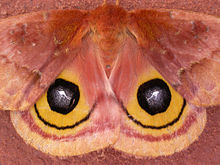 The eyespots of Automeris io
The eyespots of Automeris io
Some animals, particularly gazelles, are known to stot, which, among other things, may advertise their unprofitability to predators.[6] The moth Automeris io possesses eyespots hidden on its hindwings. When under threat, the moth suddenly reveals these spots, aiming to startle its predator. Fearful of their own consumption, predators often retreat when startled. Eyespots are also used by some animals to trick a predator into thinking it has been spotted (when in fact, it may not have been), and so is less likely to succeed in pursuit.
Avoiding capture
Many animals have highly developed senses of sight, smell, and hearing so that they can detect danger and escape. By frequently scanning and monitoring their surroundings, especially when in the open, prey can avoid attack by hoping to see a predator before it reaches the 'critical distance' for an attack. This is a standard defence mechanism for animals in open grasslands and prairies. It is also common for arboreal animals to scan both the ground around them for terrestrial predators, and the sky for aerial predators. Smaller animals may not venture too far from cover in burrows or the undergrowth, where they can quickly hide when danger approaches. Flight is of huge importance in the avoidance of predators in those species that possess it.
Animals that are the frequent target of predation often make use of 'safety in numbers'. This results in a situation where any one herd member is unlikely to be preyed upon, and in high populations, predator satiation is likely to occur. Grazing mammals often feed in social groups, also known as herds. Working as a group, a stalking predator is likely to be detected earlier, and when it attacks, the herd scatters, causing difficulty for the predator and allowing most, if not all, of the prey animals to escape. Prey animals may use alarm signals to alert the other herd members when a predator is sighted or sensed. Animals usually have a breeding season, where all the members of the species spawn at the same time, in order to maximise their young's chance of survival. This is particularly pronounced in insects such as Magicicada and the Mayfly, where millions of individuals emerge from pupation on the same day.[7]
 Muskoxen in defensive formation, horns bared and highly alert
Muskoxen in defensive formation, horns bared and highly alert
Many animals use horns, claws, and teeth to fight off predators. Some can inject venom and toxins, and skunks and bombardier beetles spray noxious chemicals to deter attackers. Mobbing, the harassing of a predator by many prey animals, is common in birds, and is usually done to protect the young in social colonies. The Eastern Honeybee mobs invading hornets, vibrating their flight muscles in order to raise the temperature around the hornet scout to lethal levels, rather than allowing the scout to bring others to their beehive.[8]
Avoiding consumption
Having been captured, an animal must prevent the predator from killing and eating it. Mechanical defences in those that possess them, such as armour and spines prevent access to softer edible parts. Distraction displays are used to direct the attention of the predator away from some vital area, such as the head, or a nest of chicks. These can be visual, as in misdirecting eyespots, behavioural, such as a mother-bird feigning injury, or chemical, as seen in the production of ink clouds by squid and octopuses.
Some animals (e.g. possums) freeze in cover or play dead when seen. Often this is accompanied by foul smells, as if their corpse is in an advanced state of decomposition, one which many animals would avoid consuming. As an absolute last line of defence, many insects taste extremely bitter, so that once a predator has begun to feed they quickly stop, and, if this is a less vital area such as a leg or a wing, the insect survives the encounter.
Some animals take a more drastic approach to defending themselves. Autotomy, the shedding of a non-vital bodypart, is utilised by some species to escape the grasp of a predator. Many lizards shed their tails when clasped, and arthropods will readily give up several legs if allows their escape. When under threat, sea cucumbers rapidly eviscerate, ejecting part or all of their digestive tract. This is done to either anchor the cucumber into a rock fissure, or to eject toxins at the predator.[9] Horned lizards, when threatened, increase the pressure in their sinus cavities until the blood vessels in the corners of the eyes burst, squirting blood at the attacker.[10] Armoured crickets and many other insect species also utilise this method, known as autohaemorrhaging.[11] These animals are able to survive the loss of these tissues, and later regenerate them.
The soldier ant caste of the Malaysian species Camponotus saundersi undergoes a process known as autothysis to defend their ant colony. The soldier ants have two large glands that run the entire length of their body, and when stressed during battle, abdominal muscles contract, causing the glands to explode, killing the ant, but spraying poison in all directions.[12][13]
Plant adaptations
Main article: Plant defense against herbivoryMany plant species have, over the course of their evolutionary history, developed physical and chemical defense mechanisms to deter herbivores. Prickles, spines, and thorns are examples of physical mechanisms. Stinging nettles are covered in small hairs that contain chemicals that are a skin irritant to many mammals, including humans.
See also
- Ultrasound avoidance
- Predator avoidance in schooling fish
References
- ^ John Alcock (1998). Animal Behavior: An Evolutionary Approach (8th ed.). Sinauer. ISBN 0-87893-009-4.
- ^ Endler (1991) In Behavioural Ecology, 3rd ed. (Krebs & Davies), pp. 169–196.
- ^ Fullick & Greenwood (1979) Am. Nat. 113, 762-765.
- ^ Edmunds, Malcolm. The Evolution of Cryptic Colour. in Insect defenses: adaptive mechanisms and strategies of prey and predators (1990) Eds. David L. Evans, Justin O. Schmidt, pg 11.
- ^ Juan Carlos Santos, Luis A. Coloma, David C. Cannatella (28 October 2003). "Multiple, recurring origins of aposematism and diet specialization in poison frogs". National Academy of Sciences. http://www.pnas.org/cgi/content/abstract/100/22/12792. Retrieved 2008-12-22.
- ^ Caro, T. M. (1986). "The functions of stotting in Thomson's gazelles: Some tests of the predictions.". Animal Behaviour (34): 663–684.
- ^ John Cooley & Dave Marshall (9 January 2000). "Periodical Cicada". University of Michigan. http://insects.ummz.lsa.umich.edu/fauna/. Retrieved 2008-12-22.
- ^ Masato Ono, Takeshi Igarashi, Eishi Ohno, and Masami Sasaki (28 September 1995). "Unusual thermal defence by a honeybee against mass attack by hornets". Nature 377 (377): 334–336. doi:10.1038/377334a0. http://www.nature.com/nature/journal/v377/n6547/abs/377334a0.html. Retrieved 2008-12-22.
- ^ Patrick Flammang, Jerome Ribesse, Michel Jangoux (2002-12-01). "Biomechanics of adhesion in sea cucumber cuvierian tubules (echinodermata, holothuroidea)". Integrative and Comparative Biology. http://findarticles.com/p/articles/mi_qa4054/is_200212/ai_n9160035/pg_1. Retrieved 2008-12-22.
- ^ Dr. Wendy Hodges. "About Horned Lizards". DigiMorph. http://www.digimorph.org/resources/horned.phtml. Retrieved 2008-12-22.
- ^ "See It to Believe It: Animals Vomit, Spurt Blood to Thwart Predators", Allison Bond, Discover Magazine blog, 28 July 2009, retrieved 17 March 2010
- ^ Maschwitz, U. and E. Maschwitz, 1974. Platzende Arbeiterinnen: Eine neue Art der Feindabwehr bei sozialen Hautflüglern. Oecologia Berlin 14:289–294 (in German)
- ^ C. Bordereau, A. Robert, V. Van Tuyen & A. Peppuy (1997). "Suicidal defensive behavior by frontal gland dehiscence in Globitermes sulphureus Haviland soldiers (Isoptera)". Insectes Sociaux 44 (3): 289–297. doi:10.1007/s000400050049.
Further reading
- Edmunds, M. 1974. Defence in Animals: A Survey of Anti-Predator Defences. Harlow, Essex & NY: Longman ISBN 0582441323
- Ruxton, G. D.; Speed, M. P.; Sherratt, T. N. (2004). Avoiding Attack. The Evolutionary Ecology of Crypsis, Warning Signals and Mimicry. Oxford: Oxford University Press. ISBN 0198528604
- Caro, T. 2005. Antipredator Defenses in Birds and Mammals. Chicago : University of Chicago Press. 591 pp. ISBN 0226094359 (hardcover version)
- Steen, J.B., Gabrielsen, G.W. & Kanwischer, J.W.: Physological aspects of freezing behavior in Willow ptarmigan hens. Acta Phys. Scand. 134: 299-304. 1988.
- Gabrielsen, G.W. & Smith, E.N.: Physiological responses assosiated with feigned death in the American opossum. Acta Phys. Scand. 123: 393-398. 1985.
- Gabrielsen, G.W. & E.N. Smith. Physiological responses to disturbance in animals. In; Wildlife and recreationists (R. Knight and K. Utzwiller. Island Press, Washington, D.C. pp. 137–153. 1995.
Classification TaxonomyModalityChemical · AuditoryBatesian · Müllerian · Mertensian · Automimicry · Pseudocopulation · Sexual · Vavilovian · Eyespots · Aggressive
Related topics Antipredator adaptation · Animal communication · Aposematism · Camouflage/Crypsis · Co-evolution · Animal coloration · Community ecology · Evolution of mimicry · Evolutionary ecology · Frequency dependent selection · Polymorphism · Signalling theory · Underwater camouflage and mimicryFeeding behaviours Carnivores adultHematophagy · Insectivore · Lepidophagy · Man-eater · Molluscivore · Mucophagy · Myrmecophagy · Ophiophagy · Piscivore · Avivore · Spongivore · Vermivore · Herpetivorereproductivecannibalistic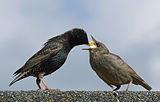
Herbivores Others Methods Apex predator · Bait balls · Bottom feeding · Browsing · Feeding frenzy · Filter feeding · Grazing · Hypercarnivore • Intraguild predation · Kleptoparasitism · Scavenging · TrophallaxisPredation · Antipredator adaptation · Carnivorous plant · Carnivorous fungus · Carnivorous protist · Category:Eating behaviors Categories:- Antipredator adaptations
- Evolutionary biology
Wikimedia Foundation. 2010.


